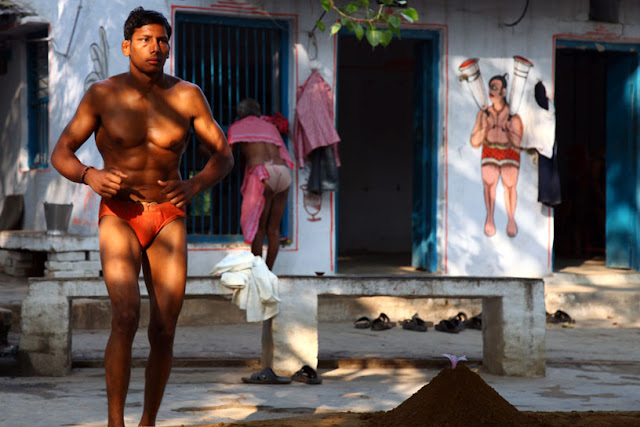Tucked away on a narrow side street and nestled behind the temple to which the akhara is affiliated, the peaceful, bucolic nature of its training ground belies its purpose. Sun streams in through green leaves, birds flit through branches, colourful paintings of chimeric figures adorn white walls. The only clues as to the real use of these gardens are a dirt ring in their centre, and the cauliflower ears and crooked nose of a bearlike man of advancing years sitting shirtless on the grass. His name is Babu and he is the akhara’s guru. Once a great competitive pehlwan, he is now responsible for the philosophical and pugilistic education of younger practitioners, many of whom turn up every day to exercise and perfect their technique.
True to form, by 7am a group of men and boys, ranging from their mid-teens to their mid-thirties, are stood around the perimeter, curling fixed-weight metal dumbbells, lifting rocks, swinging outsize stone maces and twirling wooden clubs, all in accordance with a long-established regimen largely derived from the principles of hathah yoga. In addition to gruelling workouts such as this, pehlwani demands the achievement of a holistic purity of body and mind, the balancing of passivity and passion. Consequently, to counteract the rajasic (active) nature of their chosen pastime, its teachers encourage students to adopt sattvic (calm) lifestyles of abstinence, vegetarianism, celibacy and meditation. However, the days when a wrestler could dedicate himself to the sport absolutely are long past. If only in order to afford a sattvic diet (based around milk, ghee, chickpeas, almonds and fresh vegetables) in an increasingly dynamic national economy, contemporary pehlwan, largely lower-caste men in the first place, have to take outside employment. Meanwhile, the akharas are funded by their temples and by voluntary donations from members and private individuals. Regardless of the encroachments of the modern world, a soothing air of ancient ritual and contemplation still seems to hang over this location.
The sense of tranquility is short-lived, though. At 8am, with the chime of bells and a fragrant waft of nag champa, the ring is blessed. Two men enter, dressed in bright red loincloths. One is aquiline and rangy, the other shorter and heavily muscled. Both kneel, toss handfuls of damp sand over themselves, then stand and face off. At no discernible signal, but at a point that seems perfectly apt, they clasp each other by the shoulders, leaning in to create an oppositional arch. After a brief period of exploratory pushing and shoving, the stockier of the two men forces his head down and gets underneath his opponent, driving forwards and sending clouds of orange dust into the air with his feet. In response, the taller one goes on the offensive, forcing the other man all the way to the other side of the arena. Then, in a split second, his rival reaches for his legs, whips them out from underneath him, lifts him upside down and slams him into the floor. Twin sounds mingle: one, a stifled grunt of pain, the other calling to mind the dull thud of a side of meat hitting a butcher’s block.
Compared to boxing or many of the better-known East Asian martial arts, it is easy to consider wrestling a relatively low-impact pursuit; more a two-person game of strategy and physics than anything genuinely damaging. However, the strength and agility of these men makes for truly punishing clashes. The power with which throws are performed in the many competitive bouts that occur predominantly during the “hot season” is, I am told, often bone-shattering. As this particular contest moves to the floor, pehlwani’s elaborate repertoire of chokes, holds and pins is also shown to be brutally effective. What were once two separate bodies become a single tangle of flailing limbs. As an older instructor – white-haired, bearded and dressed in a bright pink shawl – shouts advice and encouragement from the sidelines, I fire off a volley of shots with my camera, capturing blurs of motion, sprays of sand, contorted faces.





No comments:
Post a Comment